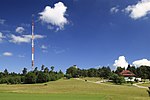Hohenzollern Castle (German: Burg Hohenzollern [bʊʁk hoːənˈtsɔlɐn] ) is the ancestral seat of the imperial House of Hohenzollern. The third of three hilltop castles built on the site, it is located atop Mount Hohenzollern, above and south of Hechingen, on the edge of the Swabian Jura of central Baden-Württemberg, Germany.
The first castle on the mountain was constructed in the early 11th century. Over the years the House of Hohenzollern split several times, but the castle remained in the Swabian branch, the dynastic seniors of the Franconian-Brandenburgian cadet branch that later acquired its own imperial throne. This castle was completely destroyed in 1423 after a ten-month siege by the free imperial cities of Swabia.
The second castle, a larger and sturdier structure, was constructed from 1454 to 1461, and served as a refuge for the Catholic Swabian Hohenzollerns, including during the Thirty Years' War. By the end of the 18th century it was thought to have lost its strategic importance and gradually fell into disrepair, leading to the demolition of several dilapidated buildings.
The third, and current, castle was built between 1846 and 1867 as a family memorial by Hohenzollern scion King Frederick William IV of Prussia. Architect Friedrich August Stüler based his design on English Gothic Revival architecture and the Châteaux of the Loire Valley. No member of the Hohenzollern family was in permanent or regular residence when it was completed, and none of the three German Emperors of the late 19th and early 20th century German Empire ever occupied the castle; in 1945 it briefly became the home of the former Crown Prince Wilhelm of Germany, son of the last Hohenzollern monarch, Kaiser Wilhelm II.
Among the historical artifacts of Prussian history contained in the castle are the Crown of Wilhelm II, some of the personal effects of King Frederick the Great, and a letter from US President George Washington thanking Hohenzollern relative Baron von Steuben for his service in the American Revolutionary War.









